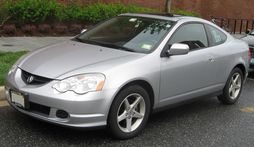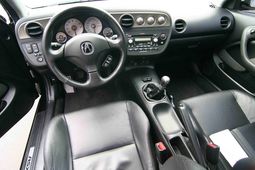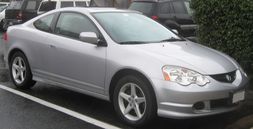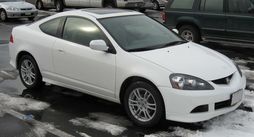The History Of Acura RSX

The Honda Integra DC5 is a Japanese vehicle, which was also known as the Acura RSX in North America and Hong Kong. It is available in base and "Type-S" trim levels in North America, and a "Integra iS / Integra Type S" and "Type R" version sold in Japan and Oceania. However, to add to the confusion, the "Type R" sold in Oceania is very similar to the "Type-S" sold in North America, and the Integra line naming in Oceania have recently been realigned so it's similar to North American conventions. Canada had three models: Base (cloth interior, no sunroof, steel wheels with wheel covers), Premium (leather interior, sunroof, alloy wheels) and Type S. In other places, (eg. Hong Kong, Singapore, Australia) only the base version is available.
When designing the Integra, Honda chose to base it on an entirely new platform, rather than incrementally re-engineering the previous Integra/ Civic platform. This new chassis would also be shared with the 2001 Civic. This was a significant change from the previous 1998 revision of the Integra, which had only been a minor refresh. In addition, this platform was the first entirely new entry-level chassis Honda had debuted since 1994. Owing to its more capable and luxurious nature, the Acura division chose to market the vehicle as the Integra's replacement, and badged it as the RSX. Touting the vehicle's more upscale feature-set and more luxurious amenities, Acura hoped to use the RSX to help garner more brand recognition and respect from older, wealthier buyers who tended to see the company's offerings, especially the Integra, as sporty and reliable, but not as mature or luxurious. Outside of North America, where the Acura division did not exist at the time, Honda chose to continue selling the model as the Integra, and continued to aim the car at younger men who wanted something more upscale than a Civic Si without having to spend considerably more money.
The Integra suspension employs MacPherson struts in the front and double-wishbone suspension in the rear. This engineering decision disappointed some Honda enthusiasts who had come to appreciate Honda's philosophy of employing double-wishbones for both front and rear suspensions. However, the K-series engine proved to have significant potential for tuning, a trait shared with the B-series engines previously employed in Integra and certain performance-oriented Civic models. The K-series engine features intelligent VTEC or (i-VTEC), which electronically adjusts valve lift, valve duration and valve timing, giving the 2.0L engine a flatter torque curve relative to previous VTEC implementations which only adjusted valve lift and valve duration.
The base Integra has the K20A3 motor with an output of 160hp (119kW) and is offered with either an automatic or a five-speed manual transmission; the Type-S has a 200hp (2002-2004) K20A2 or 210hp (157kW) in 2005 K20Z1 motor and a short-throw 6-speed manual transmission. For the 2006 model year vehicles Honda switched to the Rev 8/ 04 SAE standards for measuringhp. The base RSX for 2006 was rated at 155hp (116kW) and the Type-S was rated at 201hp (150kW). In 2005 the RSX Type-S received camshafts, b-pipe and muffler, 4.77 final drive ratio, crankshaft pulley and the intake snorkel duct from the Japanese model Honda Integra Type-R. The rev-limit was also increased from 8100 rpm to 8300 rpm. Another major change made to the inline VTEC-i engine was the use of a timing chain rather than a timing belt, which reduced maintenance needs.
The Honda Integra Type-R, sold in Japan, Australia, and some other markets, has reduced weight, a 220 PS / 164kW / 217hp (162kW) K20A I4 engine (Japan-only; Oceania models have an engine similar to the Acura RSX-S), as well as a limited slip differential (LSD) and stiffer springs and shocks, 4 piston Brembo brakes, 17" wheels on Bridgestone Potenza tires, Recaro suede seats, body trim, and more. The IIHS did not rate the RSX.
Although it had been a strong seller for Honda, the RSX did not fit within the confines of Acura's re-structured market strategy, formulated after the decision to take the Acura brand worldwide (previously, the Acura nameplate has appeared only in North America, elsewhere in the world the same models are sold as Hondas). With the introduction of the similarly powerful and less expensive 2006 model-year Honda Civic Si to the marketplace, the decision was made to discontinue production of the RSX, with the final units built in summer 2006. Because of its lower pricing and longer list of available options, Honda considered the new Civic Si to be a more viable choice for performance minded young men, who were the most common buyers of RSXs.
- Revised suspension tuning for increased handling precision and a smoother ride
- Ride height reduced by 7 mm
- Optimized damper and spring settings
- Firmer stabilizer bars (front and rear for Type-S, front for RSX)
- Bushings at suspension installation points were optimized
- Inversely wound front coil springs
- Refined steering system for enhanced feel and quicker response
- Swifter steering ratio
- Stiffer steering column
- Pump flow increased by seven percent
- Kickback reduction valve
- Optimized braking system for enhanced stopping power and feel
- Pedal stroke decreased
- Master cylinder diameter increased
- Brake pedal to rigidity increased
- Larger diameter 17-inch sport design alloy wheels and 215/ 45R17 all-season high-performance tires
- Body rigidity increased 15 percent in front and 21 percent in the rear through the application of reinforcements at key areas
- Vehicle noise and vibrations reduced
- Engine damper added to front subframe to reduce engine rocking and vibration transmitted from the engine to the cabin
- Insulation material added at key points on doors and roof to reduce road noise
- Side-mirror gaps sealed and weather strip added
- New front and rear bumper designs
- Redesigned headlight and taillight assemblies
- Restyled signature 5-sided Acura grille
- Redesigned side sill garnish
- Four new exterior colors: Magnesium Metallic, Vivid Blue Pearl, Jade Green Metallic, Blaze Orange Metallic
- Freshened interior design
- Deeply bolstered front seats with thicker cushions
- New chrome and titanium-look accents
- Meter faces changed from metallic to white
2005 & 2006 RSX Type-S Additional Enhancements:
- The engine intake and exhaust modifications that boost the power of the Type-S models to 210hp (157kW) at 7800 rpm (revised to 201hp (150kW) in 2006), compared to 200hp (150kW) at 7400 rpm on the previous model.
- Higher performance camshafts sourced from the Type-R engine
- An enlarged throttle body sourced from the Type-R engine
- Air intake duct enlarged for increased air flow
- Larger diameter exhaust pipes to increase exhaust flow obtained from the Type-R model
- Catalytic converter optimized to reduce exhaust backpressure
- Larger diameter front strut tower bar gas
- Bushings replaced by bearings on strut mount
- Deck lid spoiler
- 6-speed transmission optimized with a lower final gear ratio for quicker acceleration and carbon synchronizers replacing brass on 5th and 6th gears for a smoother shift feel
Gear Ratios for the 2005 & 2006 revision
Gear Ratios 1st Gear - 3.267 2nd Gear - 2.130 3rd Gear - 1.517 4th Gear - 1.147 5th Gear - 0.921 6th Gear - 0.738 Reverse - 3.583 Final Drive - 4.765
- The RSX was listed among Car and Driver magazine's 10 Best list for 2002 and 2003.
- John Lingenfelter Memorial Trophy
- Won the September 2005 "Cheap Speed" comparison in Car & Driver in which it was pitted against the Dodge SRT-4 ACR, Subaru Impreza WRX, Chevrolet Cobalt SS, and the Saturn Ion Redline.
- Won the May 2002 "Four Wedges & a Bubble" comparison in Car & Driver in which it was pitted against the Celica GT-S, Eclipse GTS, Hyundai Tiburon GT V6, and the VW New Beetle Turbo S.
- Won the "2001-2002 Sports Coupe" comparison from Edmunds.com in which it was pitted against the Celica GT-S, VW GTi, Prelude Type SH, Eclipse GTS, and the Mercury Cougar V6.
- Won Spike TV's "Autorox" car awards show for tastiest tuner.
- Listed as one of Spike TV's top 52 cars of all time.
- Won top ten car in SCC in 2004.
Acura won the Manufacturers' Championship of the Speed World Challenge Touring Car class in 2006, running both RSXs and TSXs. RSX drivers finished in 5th and 9th in the Drivers' Championship. Kensai Racing is using RSXs and TSXs in the KONI Challenge Series. Badged as a Honda, the DC5 won the British Touring Car Championship with Matt Neal in 2005 and 2006, for Team Dynamics (branded as Team Halfords after the title sponsor).
From Wikipedia, the free encyclopedia
More About Acura RSX




|